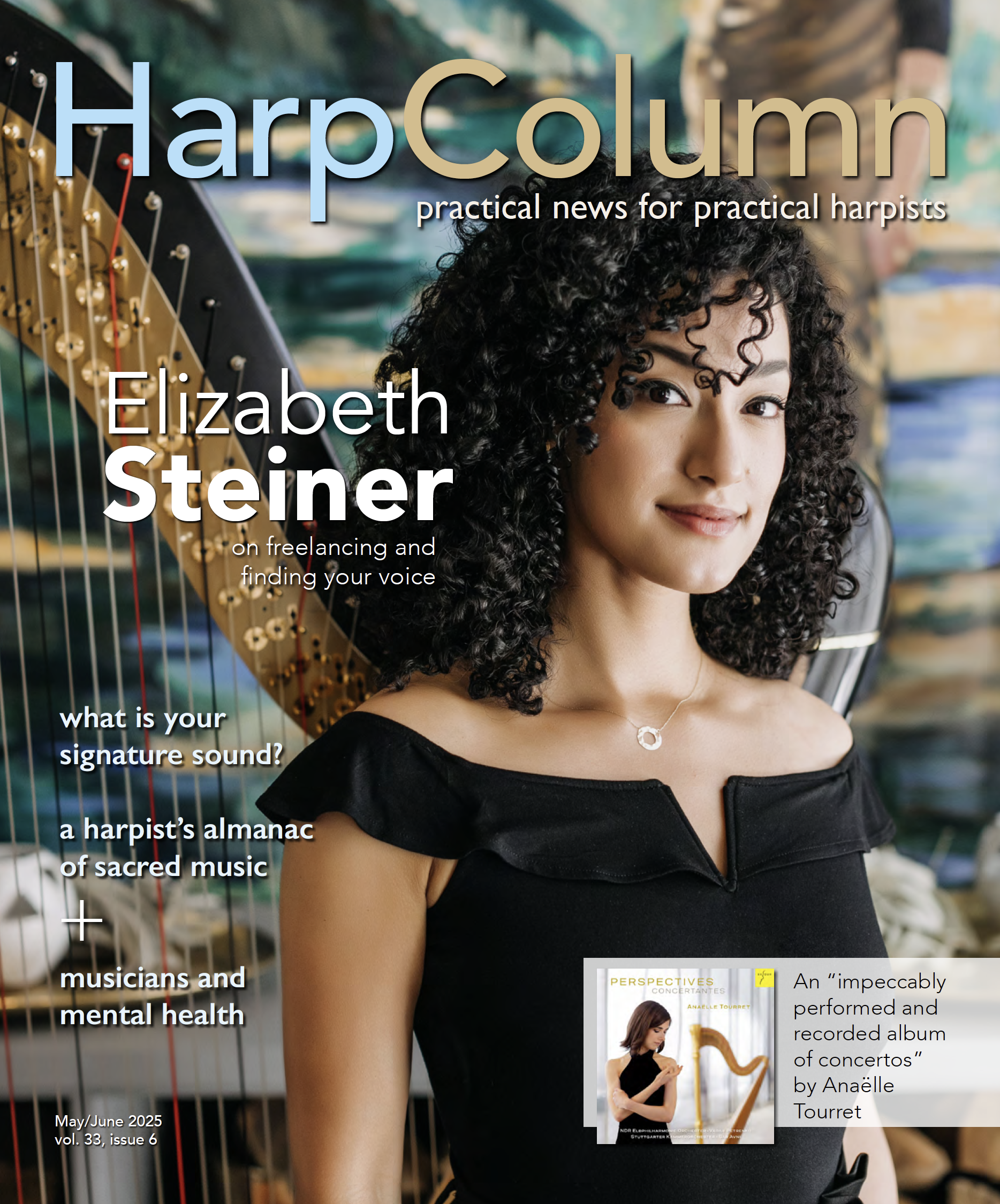Home › Forums › How To Play › Right hand harmonics
Tagged: harmonics
- This topic has 10 replies, 6 voices, and was last updated 9 years, 4 months ago by
Saul Davis Zlatkovski.
-
AuthorPosts
-
January 1, 2016 at 8:31 pm #192290
Andelin
ParticipantAnyone have any tips on right hand harmonics? If I can get them to sound at all, they are too soft to be heard, especially if the left hand is also playing. My hands are small, and my fingers are short so there’s not much space (an inch or two?) between the first finger contact point and the thumb. Maybe this is partly why? Otherwise, I’m not sure what I’m doing wrong.
Thanks!
January 2, 2016 at 10:13 am #192293Gretchen Cover
ParticipantThe best way to learn harmonics is sit with someone who knows how to do them so you can figure out what you are doing right and wrong. I don’t know if there is a harpist or harp instructor nearby you but a lesson is the easiest way to learn. Small hands and fingers have nothing to do with harmonics. It is about correct placement, pressure on the string and timing the pluck. This comes from learning how to coordinate this movement and lots of practice to make it automatic. If you can do left hand harmonics, watch how you do that and then apply what you observe to your right hand.
Initially, you could go to youtube and watch the tutorials. If that does not help you figure this out, I would encourage you to have a lesson(s) in person or try a Skype lesson.
January 2, 2016 at 12:30 pm #192295Biagio
ParticipantWhat Gretchen said plus…..
Find the exact harmonic point. For the octave harmonic (best to start with) measure the vibrating length and divide by two. Then check for the harmonic at that point to be sure if it is accurate. Many people will then mark that with a dab of white out.
It is tempting but incorrect to press firmly with the knuckle. You merely need to stop the string – and use the knuckle, not the fleshy part of your finger (the fleshy part does “work” but the tone is not as clean). Some people use the same method on the LH side.
Practice the technique on one string at higher tension until you can get to thing down smoothly. Often one in the octave below middle C is a good candidate.
Biagio
January 2, 2016 at 1:34 pm #192296Gretchen Cover
ParticipantGood thoughts but you really need to be able to play a harmonic to find the true harmonic spot:)
January 13, 2016 at 3:48 pm #192427Saul Davis Zlatkovski
ParticipantYou could safely mark the string temporarily with a white colored pencil, but never use any white out, as they contain solvents that can be absorbed into the string. The eye can naturally divide the string in half with practice. Just make sure when you look at the top of the string, you are looking at the actual top, which is shortened by levers or pedal discs when engaged.
To produce the harmonic, you only need to touch the string at the first node, the half-way point, and then play above it. You can touch the string on either side of the knuckle. Your teacher should be showing you how to do this. If you don’t have a teacher, get one.January 13, 2016 at 10:34 pm #192430Elizabeth Volpé Bligh
ParticipantOnce you have found the middle of the string, as Saul clarified, try this: don’t touch it with the knuckle yet. Position your thumb on the string you wish to play. The rest of the fingers should be flat in the palm, forming a relaxed fist. The front of the second finger should be at a ninety-degree angle to the exact middle of the same string, with the palm facing the floor. Then, move the fist away from the string about 1/8 of an inch or half a centimetre. Your thumb is still on the string and your fist is poised near the string but not on it. Twist your wrist, bringing the second finger knuckle into contact with the string, playing your harmonic. Now the palm (with the fingers still flat against it) should be facing the strings. This makes a bell-like sound, and works well for the G, A and B at the top of the range of harmonics.
January 14, 2016 at 8:07 am #192445Sylvia
ParticipantWhat size harp is it? I play a LH15, and the top strings are quite short compared to the bigger harps. If the harmonic is not gettable, I just play the natural sound an octave higher.
January 18, 2016 at 4:11 pm #192471Andelin
ParticipantThank you all for your suggestions. I am not perfect at it yet but I have made some improvement.
I play a l&h prelude. I often just play an octave above. I don’t see rh harmonics that often in lever harp music, either. Probably why I’m not very good at it, lol. The piece that brought this subject asks for harmonics in the octave above middle c, so string length isn’t an issue, but they are sometimes 1/8 notes–fast rh for harmonics, for me.
January 19, 2016 at 9:14 am #192485Biagio
ParticipantSomething no one has mentioned so I will throw it out there. Part of the question concerned volume when a harmonic is played. The physical fact is that for the same strength of pluck the harmonic will never be as loud as the fundamental. As well, there’s a limit to how hard you can attack the harmonic (which depends on practice as well as pure physics.) We simply are constrained by virtue of how our hands are shaped. As to the physics, here’s why:
When we pluck the string we may think that we hear only one note (the fundamental) but in fact we hear the partials (or harmonics) as well. Put simply, the fundamental amplitude (volume) is greater than the partials.
When the string is stopped midpoint (the octave) we have effectively shortened the vibrating length by one half. This doubles the frequency but we have done nothing to change the string tension. The long and short of that (little pun there) without getting into mathematics is that the harmonic sounds at the same amplitude as it does as an “unnoticed” partial.
So don’t despair if you are not getting the volume you want. Lots of practice will help but there is also a physical limit.
Biagio
January 19, 2016 at 1:36 pm #192491Gretchen Cover
ParticipantAndelin, if you have now figured out how to play a harmonic, I would suggest you work on just one string until you get a clear bell-like sound. Volume does not matter – go for clarity. Volume will come as you get better. Once a particular string becomes automatic, add a string or two. Then work on harmonics played on sharped strings. This is like riding a bicycle; once you learn, you never forget. Even though you may not see a lot of harmonics in your music, added harmonics with one or both hands together are great to give a little pizazz to the music or end a piece.
January 20, 2016 at 1:58 pm #192517Saul Davis Zlatkovski
ParticipantYou can play harmonics with a wide dynamic range with practice and skill, and raising helps sustain them, which gives them more volume in terms of content and size. They can project extremely well. It is rare that you need a fortissimo harmonic, but doubling it with the note an octave higher takes care of that. You can also softly double a harmonic just to reinforce it, and guarantee the pitch is there in case you miss the node and get a knocking harmonic.
If you don’t place your hand exactly on the node of the harmonic, as you probably have learned, if you are a little too high or too low, you will get an incomplete, bony sound like knocking on the string. Not a good habit. A lot of harpists never get the hang of it, unfortunately. It helps if you are used to playing on or near the center of the string. If you are used to playing much lower on the strings, then the center is harder to suddenly locate. Looking for the top of where the string is stopped, the disc pin or post just before you play should help your eye divide the string in half so you land on the node. Practice doing that. -
AuthorPosts
- You must be logged in to reply to this topic.





